|
Introduction
This month's guest
writer, Gregory
Vernitsky, has written
an entry of varied
layers related to
Kandinsky, with
glimpses of other
artists in Ukraine,
such as David Burliuk:
first Vernitsky's
own years there as a
budding artist under
Soviet rule in the
1960s and '70s,
then the tenor of
Ukraine as it shifted
in the period from
1917 to the early
1930s, and then again
farther back.
In her authoritative monograph, Kandinsky,
Dr. Jelena
Hahl-Fontaine
(formerly Hahl-Koch)
states: "Almost
nothing is known about
Kandinsky's school
years" (p. 24).
Nonetheless, confusion
persists in the
Kandinsky literature
about his time in
Odessa; for example it
is fairly often said
that he attended an
art school there.
Vernitsky, himself
from Odessa, set out
to see what might
still be learned about
this exceedingly
slippery topic. With
so many of the
hoped-for facts
seeming to be truly
lost to history,
Vernitsky has instead
given us a texture, a
train of thought, a
collection of
associations that
create a context not
only for what might
have been for
Kandinsky, but also
for any information
that still might
surface. These in
themselves offer some
admirable
clarification.
Even more, Vernitsky
shows us some of the
Kandinsky paintings
that, when threatened,
were privately
concealed; large
collections of
paintings were
scattered and many
were spirited away to
provincial museums in
Russia. This
information is
increasingly known.
But I wondered: how
remote was a
"provincial"
museum from Odessa?
Today, Krasnodar is
close to 1,400 miles
by bus. Krasnoyarsk is
2,656 miles or 23-1/2
hours by train and
then flight. The Tumen
region is over 1600
miles from Odessa.
What a feat it was to
save those paintings.
A practical note: You
will find pre-1991
Odessa referred to as
a Soviet Republic, and
as part of Soviet
Russia, the Soviet
Union, the USSR, or
the Eastern Bloc. You
will also see the
shift from the
spelling
"Odessa,"
the Russian
transliteration of the
city's name, to
"Odesa,"
Ukraine's own
spelling, post-1991,
of the name of its
sovereign nation.
Lissa Tyler Renaud
Editor, "Kandinsky Anew" Series
Oakland, California
*
Kandinsky's Odessa, Ukraine Context:
The Fate of Modern Art in the Russian Empire
Gregory Vernitsky
As
a young student in
Ukraine, the very
first names I learned
of modern artists were
Wassily Kandinsky
[1866-1944] and David
Burliuk [painter-poet,
1882-1967]. I was
walking into the
Odessa Art School to
take an entrance exam
(which I failed), when
I spotted their names,
handwritten on the
plaque listing Notable
Alumni. Hours later
their names were gone,
wiped off. Someone
told me they were
famous artists who
were prohibited, and
that the students
would simply write
their names up there
again.
It was 1968. The
public could see
French art in Moscow
and Leningrad [since
1991, St. Petersburg],
but Soviet Russian
modern art was under
constant threat of
destruction and kept
hidden. Such works
were protected by
brave and selfless
people such as V.
Pushkarev at the
Russian Museum, or I.
Savitsky at the Nukus
Museum in Central
Asia. Just a couple of
years earlier, in
Odessa, the History
Museum had burned some
of its Ukrainian art
in the courtyard: the
political leadership
of this Soviet
republic, Ukraine, was
being criticized by
the Soviet Russian
authorities for having
a nationalistic tilt
and, sniffing what was
in the air, the
museum's
administration moved
to destroy these
artworks to forestall
trouble.
Odessa was a normal
Soviet city: there
were only a few art
books, about stale
Soviet art and the
major 19th century
realists. In the
stores open to the
public, all the art
materials together
could fill only four
feet of two shelves.
The first color
reproduction of a
Kandinsky I saw was in
the early 1970s; I
treasured a book that
I couldn't read, with
a Chagall on the
cover, and a Saudi
stamp with a
Modigliani on it: you
could invite a girl to
see your albums of
Chagall, or Dali, or
Picasso—not just
listen to the latest
music!
*
But Kandinsky was much
less known. I still
have a 1972 book about
the fate of German
artists in Hitler's
time, The Art That Did Not Submit, full of letters and documents and even reproductions of works by Kathe Kollwitz, Ernst Barlach, and Paul Klee, along with other Expressionists. This book, printed in a 10,000-copy run, was unique for the USSR: a compilation of documents, printed in East and West Germany, that let the Expressionists speak for themselves. Information related to Kandinsky was (as the book was written by critics with social-realism leanings, aesthetics were secondary) very sparse—it came mostly from the political and social critics. Only one note stood out: Kandinsky was visiting Klee in Bern in 1939, to support his exiled, dying friend.
Of course the editors
of this book had a
complicated task: how
to show the Nazi
persecution of
"Degenerate
Art" without
drawing attention to
the very similar
actions of the Soviet
Government, or to the
conservative taste the
Soviets had in common
with Germany—the
taste for the
naturalistic and
heroic in art? How to
promote the
left-leaning art of
the antifascists
without talking about
their
too-conspicuously less
political Soviet
contemporaries? Well,
this book was never
reprinted.
Most books, available
to the lucky and the
persistent, were
printed in Hungary,
the DDR [the German
Democratic Republic],
Czechoslovakia, and
other countries of the
Eastern Bloc; there
was a special
bookstore called
"Friendship." Once, in
a secondhand store, I
found a book about
Modigliani (printed in
Czechoslovakia),
hidden behind other
books and, after a
huge uproar and
struggle, was able to
leave the store with
it. Do not
laugh—Modigliani
was printed in Russian
just once during the
1970s and early
'80s, two copies
of the books came to
the Odessa libraries,
and both were
immediately stolen.
From a cultural
standpoint, only North
Korea and Albania were
worse than the Soviet
Union.
People do think of
Odessa as having a
great history in the
arts—indeed,
many artists,
musicians, and writers
started out in Odessa,
then left and became
famous elsewhere. To
troll their
school's
administration, the
students secretly
adding the names
Kandinsky and Burliuk
to that plaque were
choosing very well: a
notorious
abstractionist and a
scandalous, romantic
revolutionary, who had
both left Odessa.
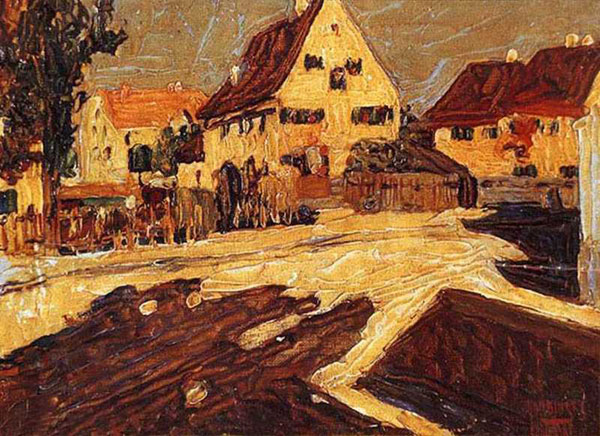
"Sunny Street" (literally "street lit by the sun"), painted in Munich:
one of four Kandinsky paintings held in the Odesa Art Museum.
Very early work (date unknown).
Besides, I do not think students in 1968 knew many other names (such
as Nathan Altman, Boris Anisfeld, or Amshey Nurenberg), or were
aware of their importance in the history of art, but they were longing
for times they had never lived in: a world in which artists could live in
Paris, travel to other countries—to Italy, or Morocco, paint what they
wanted, not listen to the authorities, be poor but one morning wake up
famous—that is, the fairytale world of Pre-WWI Europe. They may
have felt, without actual proof, that Odessa used to be a part of it.
*
Before the Revolution of 1917, the Odessa Art School that Kandinsky is
sometimes thought to have attended was a private establishment,
funded by donations and student tuition; its teachers belonged to the
Society of South Russian Artists. Also sometimes referred to as "Odessa
Art College," it was a preparatory school for an art academy or
institute, providing both art education and high school diploma.
Neither Kandinsky nor Burliuk was Jewish, but it is notable that, to a
unique extent, there were no restrictions at the Odessa Art School as to
the number of Jewish students who could attend, and who by 1904
constituted more than 60% of the student body. There were reasons so
many Jewish students famously continued their education in Paris or
Munich: few were able to continue their education at the very
conservative Academy in Saint Petersburg; the Moscow School of
Painting, Sculpture and Architecture would not admit Jews at all.
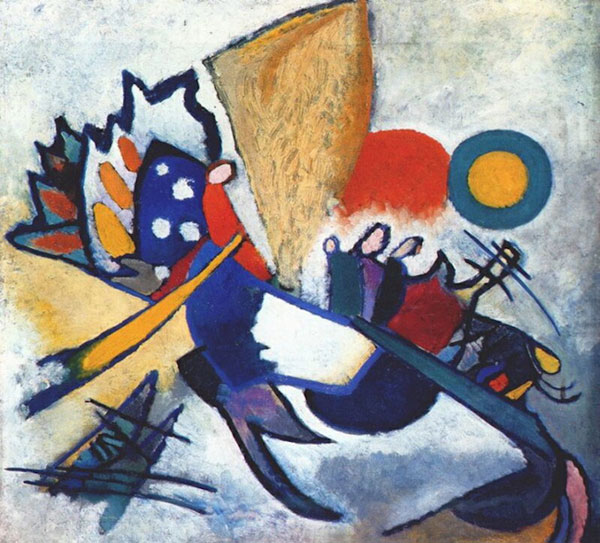
"Improvisation 209" 1917, oil on canvas. Krasnoyarsk Art Museum, Russia
Odessa was far more open to modern movements. One group of artists,
expelled from a Moscow school for having "leftist tendencies," formed
the famous Jack of Diamonds group, and initially exhibited in Odessa
with independent artists hardly known in the West: A. Nurenberg, M.
Gershenfeld, I. Malik, T. Fraerman, S. Fazini and others. They were
supported by J. Pereman, an art collector, bookseller, and leader of an
Odessan Jewish socialist movement. During the Civil War that followed
the Revolution, Pereman took his art collection to Palestine.
By the end of the Civil War in 1922, Odessa was empty. Some artists
had fled, some had moved to Moscow where, for a short time, some
modern art could flourish; some died or simply disappeared. Those
who remained had to follow new Party requirements. In early 1930 the
curtain fell, the fabric of cultural life sustaining the freedom of artistic
expression was torn.
It was a long dark night.
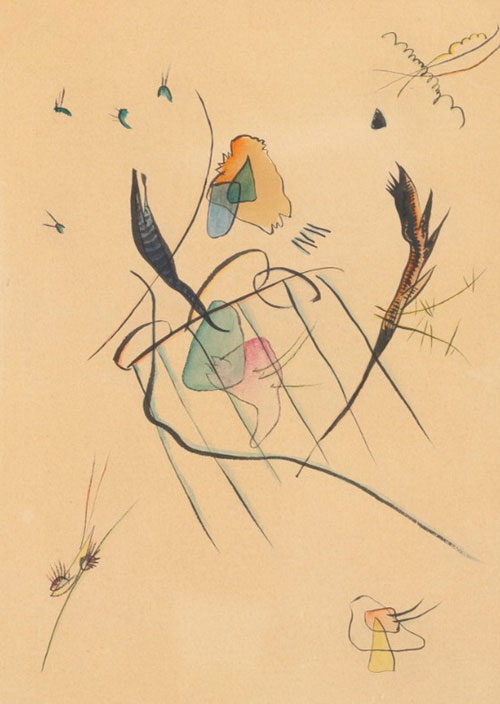
"Untitled," 1918, watercolor, ink, paper, 31 x 22cm. Private collection.
*
Kandinsky was among those who left Odessa for Moscow, then
Munich. He studied law at Moscow University, graduated, worked for a
while, and in 1896 went first to Anton Ažbe's popular Munich atelier,
or private art school, and then to the liberal Munich Fine Art Academy
["Munich Academy"] in 1900. Burliuk followed a similar path: Odessa
Art School, and then to Ažbe's Munich school and the Munich
Academy. Meeting again in Munich, Kandinsky and Burliuk helped
another former Odessa Art School student and sculptor, Vladimir
Izdebsky, to organize the 1909 and 1910 "Izdebsky Salons"—the first
and hugely influential exhibitions of modern Western Art in the
Russian Empire.
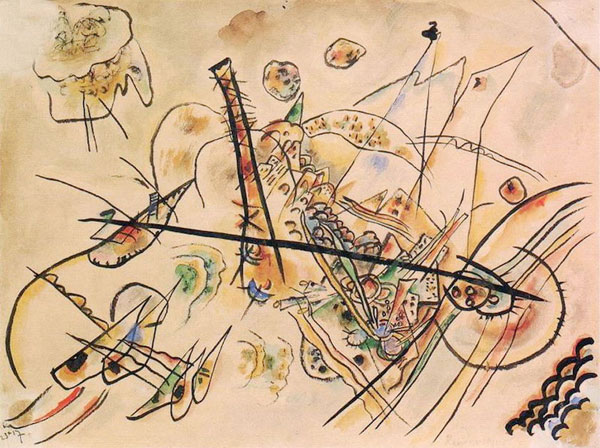
"Immaterial" (Subjectless), 1917, watercolor on paper, 25 x 34 cm.
Krasnodar Regional Art Museum.
In an all too common tale of the times, Burliuk's older brother
Vladimir, a painter, was killed in WWI; his younger brother Nikolai, a
poet, was executed by the revolutionary Bolsheviks; David Burliuk
emigrated to the U.S. in 1922. As for Kandinsky, in 1920, during the
famine in Moscow, Kandinsky's child died before his third birthday, of
malnutrition; and in 1922 Kandinsky left Russia and took a teaching
job at the Bauhaus in Weimar, Germany.
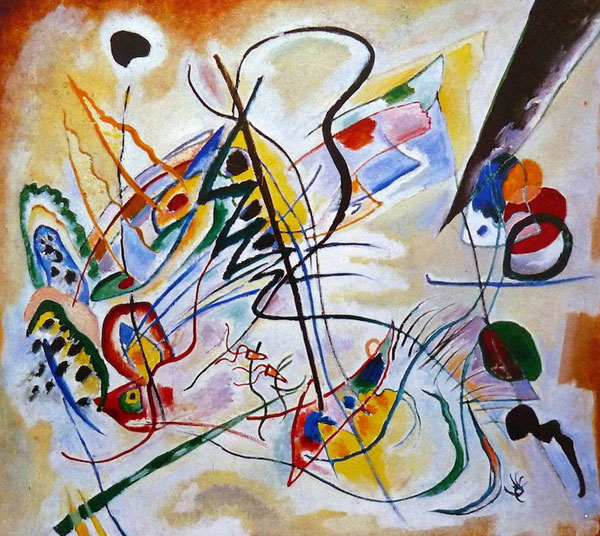
"Purple Wedge," 1919, oil on canvas, Tumen region, Museum complex.
(A point of interest: Leonid Pasternak, father of the great Boris
Pasternak [Dr. Zhivago et alia], did the same: after Odessa Art School,
he continued his education at Moscow University, then Ažbe's art
school and the Munich Academy.)
It is important to note that, although their early life trajectories were so
similar, one difference between Burliuk, Pasternak, and Kandinsky, is
that the first two graduated from Odessa Art School, while Kandinsky
perhaps did not, though he may have had a similar level of formal
training nevertheless. But we continue to see "sources" related to
Kandinsky list him as an Odessa Art School alumnus—including
online—even while most books do not.
*
Today, there is also a darker reason to talk about the tragic fate of
modern art in the Russian Empire: as Putin is denying even the
existence of Ukraine and its language, the war is raging in the culture,
too. The knowledge and understanding gained in the last 30 years—
since the dissolution of the USSR—may be lost again, and our common
cultural heritage divided by hatred and suffering. Hope it will not
happen.
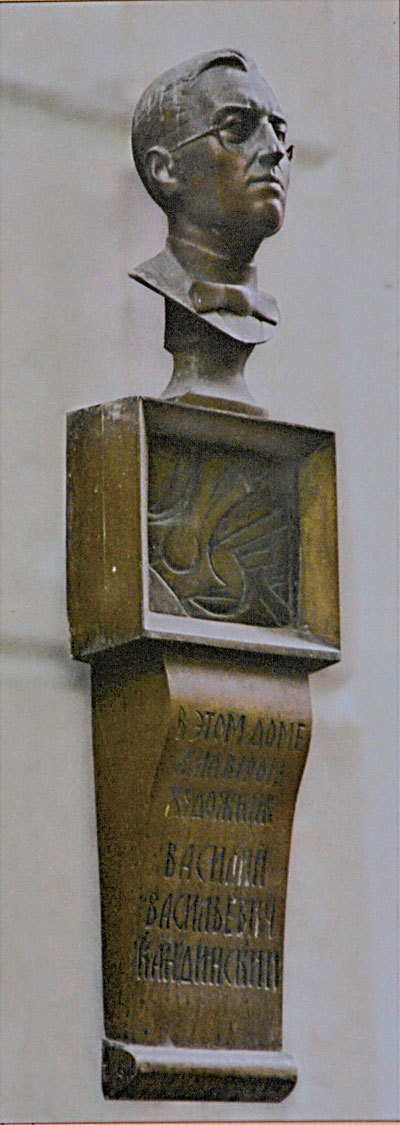
Kandinsky's memorial plaque in Odesa, where his family lived in the 1890s. Finally
installed between 1991 and 1996 (after the Soviet Union ended). By A. Tokarev.
* * *
For further reading: in this series, see "Kandinsky and the Totalitarian
State" (November 2019), by Zarina Zabrisky.
|